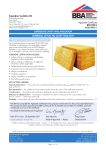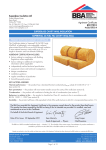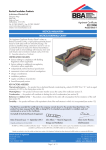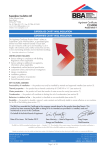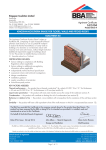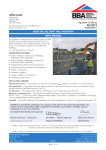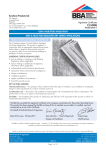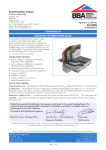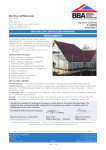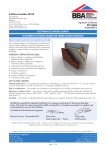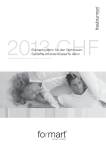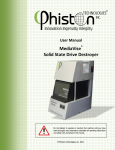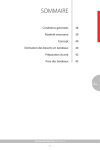Download BBA Certificate - Superglass Insulation
Transcript
APPROVAL INSPECTION TESTING CERTIFICATION Superglass Insulation Ltd Thistle Industrial Estate Kerse Road Stirling FK7 7QQ Tel: 01786 451170 Fax: 01786 451245 TECHNICAL APPROVALS FOR CONSTRUCTION Agrément Certificate 89/2231 e-mail: [email protected] website: www.superglass.co.uk Product Sheet 3 SUPERGLASS CAVITY WALL INSULATION SUPERWALL 32 DUAL PURPOSE CAVITY WALL BATT PRODUCT SCOPE AND SUMMARY OF CERTIFICATE This Certificate relates to Superwall 32 Dual Purpose Cavity Wall Batt, a lightweight, non-combustible, unfaced glass mineral wool batt for use as full or partial fill thermal insulation in new external masonry cavity walls up to 25 m in height in domestic and non-domestic buildings. AGRÉMENT CERTIFICATION INCLUDES: • factors relating to compliance with Building Regulations where applicable • factors relating to additional non-regulatory information where applicable • independently verified technical specification • assessment criteria and technical investigations • design considerations • installation guidance • regular surveillance of production • formal three-yearly review. KEY FACTORS ASSESSED Thermal performance — the product has a declared thermal conductivity (90/90 value) of 0.032 W·m–1·K –1 (see section 5). Rain penetration — the product will resist water transfer across the cavity of the walls (see section 6). Condensation — the product will contribute to limiting the risk of condensation (see section 7). Behaviour in relation to fire — the product is classified as Class A1 reaction to fire in accordance with BS EN 13501-1 : 2007 (see section 8). Durability — the product will have a life equivalent to that of the wall structure in which it is incorporated (see section 11). The BBA has awarded this Agrément Certificate to the company named above for the product described herein. This product has been assessed by the BBA as being fit for its intended use provided it is installed, used and maintained as set out in this Certificate. On behalf of the British Board of Agrément Date of First issue: 20 September 2011 Sean Moriarty Greg Cooper Head of Approvals — Physics Chief Executive The BBA is a UKAS accredited certification body — Number 113. The schedule of the current scope of accreditation for product certification is available in pdf format via the UKAS link on the BBA website at www.bbacerts.co.uk Readers are advised to check the validity and latest issue number of this Agrément Certificate by either referring to the BBA website or contacting the BBA direct. British Board of Agrément Bucknalls Lane Garston, Watford Herts WD25 9BA ©2011 Page 1 of 16 tel: 01923 665300 fax: 01923 665301 e-mail: [email protected] website: www.bbacerts.co.uk Regulations In the opinion of the BBA, Superwall 32 Dual Purpose Cavity Wall Batt, if used in accordance with the provisions of this Certificate, will meet or contribute to meeting the relevant requirements of the following Building Regulations: The Building Regulations 2010 (England and Wales) Requirement: C2(a) Resistance to moisture Comment: The product does not absorb water by capillary action and, therefore, may be used in situations where it bridges the damp-proof course (dpc) of the inner or outer leaves. See section 6.1 of this Certificate. Requirement: C2(b) Resistance to moisture Comment: Tests by the BBA indicate that a wall incorporating the product can resist rain penetration and satisfy this Requirement. See sections 3.3, 3.7, 3.9 and 6.2 of this Certificate. Requirement: C2(c) Resistance to moisture Comment: The product can contribute to satisfying this condensation Requirement. See sections 7.1 and 7.3 of this Certificate. Requirement: L1(a)(i) Conservation of fuel and power Comment: Requirement: Regulation 7 Materials and workmanship Comment: The product is acceptable. See section 11 and the Installation part of this Certificate. The product can contribute to meeting this Requirement. See sections 5.2 and 5.3 of this Certificate. The Building (Scotland) Regulations 2004 (as amended) Regulation: 8(1) Regulation: Standard: 9 2.6 3.4 3.10 3.15 6.1(b) 6.2 7.1(a)(b) Statement of sustainability The product can contribute to meeting the relevant Requirements of Regulation 9, Standards 1 to 6 and therefore will contribute to a construction meeting a bronze level of sustainability as defined in this Standard. In addition the product can contribute to a construction meeting a higher level of sustainability as defined in this Standard, with reference to clauses 7.1.4(1)(2) Aspects 1(1)(2) and 2(1), 7.1.6(1)(2) Aspects 1(1)(2) and 2(1) and 7.1.7(1)(2) Aspect 1(1)(2). See sections 5.2 and 5.3 of this Certificate. Comment: Regulation: Carbon dioxide emissions Building insulation envelope The product can contribute to satisfying clauses, or parts of clauses, 6.1.1(1), 6.1.2(2), 6.1.6(1), 6.2.1(1)(2), 6.2.3(1), 6.2.9(1), 6.2.10(2), 6.2.11(1) and 6.2.12(2). See sections 5.2 and 5.3 of this Certificate. Comment: Standard: Condensation The product can contribute to satisfying this Standard, with reference to clauses 3.15.1(1), 3.15.3(1) and 3.15.4(1). See sections 7.2 and 7.3 of this Certificate. Comment: Standard: Standard: Precipitation Walls incorporating this product can satisfy this Standard, with reference to clause 3.10.1(1)(2). See sections 3.3, 3.7, 3.9 and 6.2 of this Certificate. Comment: Standard: Moisture from the ground The product does not absorb water by capillary action and, therefore, may be used in situations where it bridges the dpc of the inner or outer leaf, with reference to clauses 3.4.1(1) and 3.4.5(1)(2). See section 6.1 of this Certificate. Comment: Standard: Building standards — construction Spread to neighbouring buildings The product has a classification A1 and is unrestricted by clauses 2.6.5(1) and 2.6.6(2). See section 8.5 of this Certificate. Comment: Standard: Fitness and durability of materials and workmanship The product can contribute to a construction meeting this Regulation. See section 11 and the Installation part of this Certificate. Comment: 12 Building standards — conversions All comments given for this product under Regulation 9, also apply to this Regulation, with reference to clauses 0.12.1(1) and Schedule 6(1). Comment: (1) Technical Handbook (Domestic). (2) Technical Handbook (Non-Domestic). The Building Regulations (Northern Ireland) 2000 (as amended) Regulation: B2 Fitness of materials and workmanship Comment: Regulation: C4(a) Resistance to ground moisture and weather The product is acceptable. See section 11 and the Installation part of this Certificate. The product does not absorb water by capillary action and, therefore, may be used where it bridges the dpc of the inner or outer leaf. See section 6.1 of this Certificate. Comment: Regulation: Comment: C4(b) Resistance to ground moisture and weather Walls incorporating this product can satisfy this Regulation. See sections 3.3, 3.7, 3.9 and 6.2 of this Certificate. Page 2 of 16 Regulation: C5 Condensation Comment: Regulation: Regulation: F2(a)(i) F3(2) Conservation measures Target carbon dioxide Emissions Rate The product can contribute to satisfying this Regulation. See section 7.3 of this Certificate. Comment: The product can contribute to satisfying these Regulations. See sections 5.2 and 5.3 of this Certificate. Construction (Design and Management) Regulations 2007 Construction (Design and Management) Regulations (Northern Ireland) 2007 Information in this Certificate may assist the client, CDM co-ordinator, designer and contractors to address their obligations under these Regulations. See section: 2 Delivery and site handling (2.4) of this Certificate. Non-regulatory Information NHBC Standards 2011 NHBC accepts the use of Superwall 32 Dual Purpose Cavity Wall Batt when installed and used in accordance with this Certificate, in relation to NHBC Standards, Chapter 6.1 External masonry walls. Technical Specification 1 Description 1.1 Superwall 32 Dual Purpose Cavity Wall Batt consists of layers of bonded, water repellent treated, glass wool, formed into resilient batts using a resin binder. They are manufactured in accordance with BS EN 13162 : 2008. 1.2 The batts are heat cured and have the nominal characteristics as shown in Table 1. Table 1 Nominal characteristics Length (mm) 1200 Width (mm) 455 Thickness (mm) 50 to 150 (in 5 mm increments) Density (kg·m ) 36 –3 1.3 For the partial fill application, cavity wall ties in accordance with BS EN 845-1 : 2003 and BS 5628-3 : 2005 or those approved by the BBA, are suitable for use with the batts. 2 Delivery and site handling 2.1 The product is supplied wrapped in polyethylene to provide short term protection. Each pack carries a label bearing the manufacture’s name, product description, essential instructions for installation and the BBA identification mark incorporating the number of this Certificate. 2.2 The product should be stored clear of the ground, on a clean level surface and preferably under cover to protect it from prolonged exposure to moisture or mechanical damage. 2.3 Partially completed walls should be protected from inclement weather (wind, rain and snow) and covered at the end of a day’s work. 2.4 It is recommended that dust masks, gloves and long sleeved clothing are worn during cutting and handling of the product. Assessment and Technical Investigations The following is a summary of the assessment and technical investigations carried out on Superwall 32 Dual Purpose Cavity Wall Batt. Design Considerations 3 General 3.1 Superwall 32 Dual Purpose Cavity Wall Batt is satisfactory for use as full or partial fill thermal insulation in new external masonry cavity walls up to 25 m in height in domestic and non-domestic buildings. 3.2 The batts are effective in reducing the thermal transmittance (U value) of new external cavity walls with masonry inner and outer leaves, where masonry includes clay and calcium silicate bricks, concrete blocks, natural and reconstituted stone blocks. It is essential that such walls are designed and constructed to incorporate the normal precautions to prevent moisture penetration. Page 3 of 16 3.3 Walls should be designed and constructed in accordance with the relevant recommendations of: • • • • BS BS BS BS EN 1996-1-1 : 2005, BS EN 1996-1-2 : 2005, BS EN 1996-2 : 2006 and BS EN 1996-3 : 2006 5628-1 : 2005 5628-3 : 2005, with particular reference to Clause 5.5 Exclusion of water 8000-3 : 2001. 3.4 It is recommended that installation is continuous up to the highest level on each wall. If it is terminated at any other level, the top edge of the insulation must be protected by a cavity tray with stopends and weepholes at alternative perpends (full fill). The cavity must be capped in brick or block or suitable board material (partial fill). 3.5 The use of cavity battens and/or boards during construction is strongly recommended to prevent bridging by mortar droppings. 3.6 To reduce the risk of water penetration, raked or recessed mortar joints should not be used in full fill applications. For partial fill applications, please refer to the conditions as set out in NHBC Standards, Chapter 6.1 External masonry walls. 3.7 The product is for use in any exposure zone in buildings up to 25 m in height, subject to the conditions set out in this Certificate being met. However, the use of the product does not preclude the need to apply any external render coat or other suitable finish in severe exposure zones where such application would be normal practice. 3.8 As with any other form of cavity wall insulation, where buildings need to comply with NHBC Standards 2011, specifiers should observe the requirements of these Standards. Full fill use Buildings up to and including 12 metres high 3.9 The design conditions to be followed are: • that the insulation completely fills the cavity • that the insulation thickness should remain constant where possible. Should any change in vertical thickness occur, a horizontal damp-proof cavity tray should separate each thickness change • a minimum thickness of 50 mm should be maintained where possible. Where, for structural reasons, the insulation thickness is reduced, eg by the intrusion of ring beams, a minimum thickness of 25 mm insulation should be maintained and the manufacturer’s advice on fixing and weatherproofing sought. Buildings over 12 m high and up to and including 25 m high 3.10 Where the walls of a building are between 12 m and 25 m high, the following requirements also apply: • from ground level, the maximum height of continuous cavity must not exceed 12 m. Above 12 m, the maximum height of continuous cavity must not exceed 7 m • the area to be insulated must not be an infill panel in a framed structure • the Certificate holder in association with the architect shall carry out the detailed programme of assessment of the project including an examination of the quality of installation as work progresses. Above average site supervision is recommended during installation • Certification relates only to buildings where the Certificate holder has given written approval for use of the product on the specified building. Partial fill use Buildings up to and including 12 metres high 3.11 For partial fill applications, the minimum residual cavity width to be maintained during construction must be 25 mm. To achieve this requirement, a greater nominal residual cavity width may need to be specified at the design stage to allow for inaccuracies inherent in the building process. The specifier may either: • design a cavity width by consideration of the dimensional tolerances of the components which make up the wall by reference to the British Standards relating to the bricks, blocks and boards, or use the data from their respective manufacturers. In addition, allowance may need to be made for the quality of available building operatives and the degree of site supervision or control available, or • design a nominal residual cavity width of 50 mm (a residual cavity nominally 50 mm wide will be required by the NHBC, where normal standards of tolerance and workmanship are adopted). 3.12 The size of residual cavity obtained in the processes described in section 3.11 is also subject to the following limitations in respect of exposure of the proposed building as set out in Table 2. Page 4 of 16 Table 2 Maximum allowable total exposure factors of different constructions Construction Maximum allowable exposure factor E (1) All external masonry walls protected by: rendering (to BS EN 13914-1 : 2005) tile hanging slate hanging timber, plastic or metal weatherboarding or cladding no restriction One or more external masonry walls constructed from facing clay brickwork or natural stone, the porosity of which exceeds 20% by volume. Mortar joints must be flush pointed or weatherstruck. 100 One or more external masonry walls constructed from calcium silicate bricks, concrete blocks, reconstituted stone or natural stone, the porosity of which is less than 20% by volume, or any material with raked mortar joints 88 (1) Based upon the approach in BS 5618 : 1985 and also outlined in BBA Information Sheet No 10. Buildings over 12 m high and up to and including 25 m high 3.13 The width of the residual clear cavity to be achieved is to be in excess of 50 mm, and the following requirements apply: • from ground level the maximum height of continuous cavity walls must not exceed 12 metres; above 12 metres the maximum height of continuous cavity walls must not exceed 7 metres. In both cases breaks should be in the form of continuous horizontal cavity trays and weepholes discharging to the outside • the specifier must take extra care when detailing to ensure that the introduction of the insulation does not affect the weather resistance of the wall. More than average site supervision is recommended during the installation of the product • where, for structural reasons, the cavity width is reduced, eg by the intrusion of ring beams, a minimum residual cavity width of 25 mm must be maintained and extra care must be taken with fixings and weatherproofing, eg the inclusion of cavity trays with weepholes. 4 Practicability of installation The product is designed to be installed by a competent general builder, or a contractor, experienced with this type of product. 5 Thermal performance 5.1 Calculations of thermal transmittance (U value) should be carried out in accordance with BS EN ISO 6946 : 2007 and BRE Report (BR 443 : 2006) Conventions for U-value calculations, using the manufacturer’s declared thermal conductivity (90/90 value) of 0.032 W·m–1·K–1. 5.2 The U value of a completed wall will depend on the selected insulation thickness, number and type of fixings, the insulating value of the substrate masonry and its internal finish. Calculated U values for example constructions are given in Tables 3 and 4. Table 3 Example partial fill cavity wall U values (1) — New buildings U value requirement (W·m–2·K–1) 0.19 0.25 0.26 0.27 0.30 0.35 Insulation thickness (mm) 13 mm Dense plaster 100 mm Dense block(2)(4) Plasterboard on dabs 100 mm AAC block(3) 160 115 110 105 95 80 135 90 85 80 70 55 (1) Assumes air gap correction, ⌬U = 0.01. Assume fixings correction for fully penetrating steel fixings (50 W·m–1·K–1) at 2.5 m2 with cross sectional area of 12.5 mm2. Construction includes 102.5 mm thick brick outer leaf and 50 mm residual cavity. (2) Block and mortar thermal conductivity 1.13 W·m–1·K–1 and 0.88 W·m–1·K–1 respectively. (3) Block and mortar thermal conductivity 0.12 W·m–1·K–1 and 0.88 W·m–1·K–1 respectively. (4) Plaster thermal conductivity 0.57 W·m–1·K–1. Page 5 of 16 Table 4 Example full fill cavity wall U values (1) — New buildings U value requirement (W·m–2·K–1) Insulation thickness (mm) 13 mm Dense plaster 100 mm Dense block(2)(4) Plasterboard on dabs 100 mm AAC block(3) 170 125 120 115 100 85 145 100 95 90 75 60 0.19 0.25 0.26 0.27 0.30 0.35 (1) Assumes air gap correction, ⌬U = 0.01. Assume fixings correction for fully penetrating steel fixings (50 W·m–1·K–1) at 2.5 m2 with cross sectional area of 12.5 mm2. Construction includes 102.5 mm thick brick outer leaf. (2) Block and mortar thermal conductivity 1.13 W·m–1·K–1 and 0.88 W·m–1·K–1 respectively. (3) Block and mortar thermal conductivity 0.12 W·m–1·K–1 and 0.88 W·m–1·K–1 respectively. (4) Plaster thermal conductivity 0.57 W·m–1·K–1. 5.3 The product can maintain, or contribute to maintaining, continuity of thermal insulation at junctions between elements and openings. For Accredited Construction Details the corresponding psi values in BRE Information Paper IP1/06 Assessing the effects of thermal bridging at junctions and around openings, Table 3 may be used in carbon emission calculations in Scotland and Northern Ireland. Detailed guidance for other junctions and on limiting heat loss by air infiltration can be found in: England and Wales — Approved Documents to Part L and for new thermal elements to existing buildings, Accredited Construction Details (version 1.0). See also SAP 2009 Appendix K and the iSBEM User Manual for new-build Scotland — Accredited Construction Details (Scotland) Northern Ireland — Accredited Construction Details (version 1.0). 6 Rain penetration 6.1 When the product is used in situations where it bridges the dpc in walls, dampness from the ground will not pass through to the inner leaf provided the cavity wall is detailed in accordance with the requirements and provisions of the national Building Regulations: England and Wales — Approved Document C, section 5 Scotland — Mandatory Standard 3.4, clause 3.4.1(1) (1) Technical Handbook (Domestic). Northern Ireland — Technical Booklet C, section 1.6. 6.2 Results of tests on full fill applications confirm that constructions built in accordance with BS 5628-3 : 2005 will prevent water reaching the inner leaf in damaging amounts. Water penetrating the outer leaf of the wall, will drain down the cavity face of the outer leaf, and therefore, the product will contribute to satisfying the national Building Regulations: England and Wales — Requirement C, section 5 Scotland — Mandatory Standard 3.10, clause 3.10.1(1)(2) (1) Technical Handbook (Domestic). (2) Technical Handbook (Non-Domestic). Northern Ireland — Technical Booklet C, Section 2. 6.3 In all situations, it is particularly important to ensure during installation that: • installation is carried out to the highest level on each wall or the top edge of the insulation is protected by a cavity tray • wall ties are installed correctly and are thoroughly clean • excess mortar is cleaned from the cavity face of the leading leaf and any debris removed from the cavity • mortar droppings are cleaned from the exposed edges of installed batts • cavity trays are used with appropriate stop ends and weep holes at lintel level • dpc’s at ground level do not project into the cavity as they can form a trap for mortar bridging. 7 Condensation Surface condensation 7.1 Walls will limit the risk of surface condensation adequately when the thermal transmittance (U value) does not exceed 0.7 W·m–2·K–1 at any point, and the junctions with floors, roofs and openings are designed in accordance with Limiting thermal bridging and air leakage : Robust construction details for dwellings and similar buildings TSO 2002, BRE Information Paper IP IP1/06 or section 5.3 of this Certificate. Page 6 of 16 7.2 For buildings in Scotland, constructions will be acceptable where the thermal transmittance (U value) of the wall does not exceed 1.2 W·m–2·K–1 at any point and openings and junctions with other elements comply with the guidance given in BS 5250 : 2002, section 8 or section 5.3 of this Certificate. Additional information can be found in BRE Report (BR 262 : 2002) Thermal insulation: avoiding risks. Interstitial condensation 7.3 Walls will limit the risk of interstitial condensation adequately when they are designed and constructed in accordance with BS 5250 : 2002, section 8, Annex D. 7.4 The product has a nominal vapour resistivity of 7 MN·s·g–1·m–1 to 10 MN·s·g–1·m–1. 8 Behaviour in relation to fire 8.1 The product does not prejudice the fire-resistance properties of the wall. The product has a Reaction to fire Class A1 rating when classified in accordance with BS EN 13501-1 : 2007. 8.2 The requirements of the Building Regulations relating to fire spread in cavity walls can be met in buildings of all purpose groups without the need for cavity barriers, where the cavity is fully filled or the construction complies with the provisions detailed in: England and Wales — Approved Document B, Volume 1, Diagram 13 and Volume 2, Diagram 34 Northern Ireland — Technical Booklet E, Diagram 3.5. 8.3 A summary of these provisions is given here: • the wall must consist of masonry inner and outer leaves, each at least 75 mm thick • the cavity must not be more than 300 mm wide (Northern Ireland only) • the cavity must be closed at the top of the wall and at the top of any opening • in addition to the insulation, only the following combustible materials shall be placed in, or exposed to, the cavity: — timber lintels, window or door frames, or end of timber joists — pipe, conduit or cable — dpc, flashing, cavity closer or wall tie — domestic meter cupboard, provided that there are not more than two cupboards to a dwelling, the opening in the outer leaf is not more 800 mm by 500 mm for each cupboard, and the inner leaf is not penetrated except by a sleeve not more than 80 mm by 80 mm, which is fire-stopped. 8.4 For constructions not covered by sections 8.2 and 8.3, cavity barriers must be provided to comply with: England and Wales — Approved Document B, Volume 1, section 6 and Volume 2, section 9 Scotland — Mandatory Standard 2.4, Clauses 2.4.1(1)(2), 2.4.2(1)(2), 2.4.7(1) and 2.4.9(2) (1) Technical Handbook (Domestic). (2) Technical Handbook (Non-Domestic). Northern Ireland — Technical Booklet E, paragraphs 3.35 to 3.39. 8.5 The product is classified as non combustible and is therefore unrestricted by clauses 2.6.5(1) and 2.6.6(2). (1) Technical Handbook (Domestic). (2) Technical Handbook (Non-Domestic). 9 Proximity of flues and appliances When installing the product in close proximity to certain flue pipes and/or heat producing appliances, the relevant provisions of the documents supporting the national Building Regulations are applicable: England and Wales — Approved Document J Scotland — Mandatory Standard 3.19, clauses 3.19.1(1)(2) to 3.19.4(1)(2) (1) Technical Handbook (Domestic). (2) Technical Handbook (Non-Domestic). Northern Ireland — Technical Booklet L. 10 Maintenance As the product is confined within the wall cavity and it has suitable durability (see section 11), maintenance is not required. 11 Durability The product is durable, rot-proof, water resistant and sufficiently stable to remain effective as an insulant for the life of the building. Page 7 of 16 Installation 12 General 12.1 The walls are constructed leading with either inner or outer leaf with Superwall 32 Dual Purpose Cavity Wall Batt fixed to the cavity face of the leading leaf. In partial fill use it is recommended that the inner leaf is constructed ahead of the outer leaf, as batts fastened to the cavity face of the inner leaf, give a slightly enhanced thermal performance. In full fill use it is recommended that the external leaf is constructed ahead of the internal leaf so that any mortar protruding into the cavity space from the back of the external leaf can be cleaned off before installing the product. Batts must not be pushed into a completed cavity. 12.2 If installation of the batts is terminated below the highest level of the wall, the top edge of the insulation must be protected by a cavity tray and alternate perpend joints raked out to provide adequate drainage of water from this tray. Supervision requirements for buildings over 12 m and up to 25 m in height 12.3 To comply with this Certificate, the Certificate holder’s specialists experienced in site practice and installation will attend the site and provide demonstrations to ensure correct installation from the outset. 12.4 Adequate supervision of the installation must be maintained and the Certificate holder’s specialists must have right of access to site to ensure correct installation. 13 Procedure Full fill 13.1 Walls are constructed in the conventional manner, with the first row of the wall ties, at maximum 600 mm horizontal spacing, positioned where the insulation is to begin. It is recommended that the wall ties are not placed directly on the dpc. The first run of batts may commence below dpc level to provide some edge insulation to the floor. 13.2 A section of the wall leaf is built up to a course above the next row of wall ties, which are placed at the usual spacing of 450 mm vertically. 13.3 The batt is compressed slightly and placed between the upper and lower wall ties to form a closely butt-jointed run (see Figure 1). Figure 1 Installation of batts between upper and lower wall ties 13.4 The drip on each of the upper wall ties is inserted into the top of the batt and must be positioned to shed water away from the inner leaf. This is important to ensure that it functions correctly. 13.5 The other leaf is built up to the same level as the batt, with its inner face in contact with the batts. 13.6 Successive sections of the wall, incorporating wall ties, are constructed and the batt installed as work proceeds up to the required height. Vertical joints must be staggered and all joints tightly butted. Where protrusions occur in the cavity or extra wall ties are used, the batt should be carefully cut to fit. 13.7 For wide cavities it is possible to use two layers of batts with vertical joints staggered both between layers and within layers. Appropriate wall ties should be used to accommodate the extra width of cavity and if unequal thickness of batts are used, the thinner layer should be placed nearest the outer brick leaf. 13.8 After each section of the wall leaf is built, excess mortar should be removed from the cavity and mortar droppings cleaned from exposed edges of the installed batt (see Figure 2) before installation of the next section of batts. Use of a cavity board is recommended to protect batt edges and make cleaning easier. Page 8 of 16 Figure 2 Use of a cavity board when cleaning off mortar 13.9 It is recommended that the thinner batts (50 mm to 75 mm) are bent round corners (see Figure 3). Thicker batts should be close butt jointed at corners to avoid cold bridges. Figure 3 Batts bent round corners 13.10 Where openings such as doors and windows are in close proximity it is recommended that a continuous lintel or cavity tray is used. Individual lintels or trays should have stop ends and weepholes and be drained. 13.11 Batts can be cut with a sharp knife to fit around windows, doors, apertures and air bricks. 13.12 It is essential that cut pieces completely fill the spaces for which they are intended and no gaps must be left in the insulation. 13.13 Small pieces must be fitted with the fibre orientation parallel to the plane of the wall. 13.14 Batts should always be installed to the highest level of each wall (see section 12.2). 13.15 It is recommended that when the outer leaf is built, the inner face must be in contact with the product and also the permitted deviation in the cavity width be as shown in Table 5. Page 9 of 16 Table 5 Deviation in cavity width Insulation thickness (mm) Permitted Deviation (mm) 50 65 75 85 90 100 110 120 130 140 150 50-60 65-75 75-85 85-100 90-105 100-115 110-125 120-135 130-150 140-160 150-170 Partial fill 13.16 A section of the leading leaf is built with the first row of wall ties, at approximately 600 mm horizontal spacing, positioned where the insulation is to begin. It is recommended that the wall ties are not placed directly on the dpc. The first run of batts may commence below dpc level to provide some edge insulation for the floor (see Figure 1). 13.17 The leading leaf is then built to the required height with the wall ties at a vertical spacing of 450 mm. It is essential that all wall ties slope downwards towards the outer leaf. The batts are then compressed slightly between the upper and lower wall ties, behind the retaining clips or wheels to form a closely butt-jointed run (see Figure 4). Figure 4 Wall tie detail wall ties must slope down towards outer leaf dpc 13.18 Where insulation retaining ties clips are sufficient for structural purposes, horizontal spacing should be 450 mm or 600 mm(1) depending on the thickness of the inner leaf. (1) Although a maximum horizontal spacing of 900 mm is permitted for structural purposes by BS 5628-3 : 2005 the spacing should be no more than 600 mm to ensure adequate retention of the batt. 13.19 The other leaf is then built up to the level of the top of the batts. 13.20 Successive sections of wall incorporating approved wall ties are constructed and batts installed as work proceeds up to the required height. 13.21 Where additional ties are required at less than 450 mm vertical spacing, the batts must be cut and neatly fitted around them. Under no circumstances should the batts be impaled by the ties. 13.22 It is recommended that the thinner batts (up to 50 mm) are bent round corners (see Figure 5). Thicker batts should be close butt-jointed at corners to avoid bridges. Page 10 of 16 Figure 5 Batts bent round corners — partial fill 13.23 After each section of the leading leaf is built, excess mortar should be removed from the cavity face and mortar droppings cleaned from exposed edges of the installed batts before installation of the next run of batts. Use of a cavity board is recommended to protect batt edges and make cleaning easier, also, a cavity batten will protect the installed batts and help to keep a cavity clean as the following leaf is built (see Figures 6 and 7). Figure 6 Use of cavity board Page 11 of 16 Figure 7 Use of cavity batten 13.24 Batts can be cut, using a sharp knife or fine-toothed saw, to fit around windows, doors, air bricks etc. It is essential that cut pieces completely fill the spaces for which they are intended and that no gaps are left in the insulation. 13.25 Small pieces must be fitted with the fibre orientation parallel to the plane of the wall. 13.26 Batts should always be installed to the highest level of each wall. If installation of the batts is terminated at any other level, the top edge of the insulation must be protected by a cavity tray and alternate perpend joints raked out to provide adequate drainage of water from the tray. Protection 13.27 Exposed areas of batts should always be covered at the end of a day’s work or in driving rain. 13.28 All building involving the product, particularly interrupted work, must conform to BS EN 1996-2 : 2006, Sections 3.2 Acceptance, handling and storage of materials and 3.6 Curing and protective procedures during execution. Page 12 of 16 Technical Investigations 14 Tests Results of tests were assessed to determine: • dimensional accuracy • density of air-dry batts • resistance to water penetration • water uptake and saturation • efficiency of the fixing system. 15 Investigations 15.1 During manufacture, quality control checks are carried out for: • density • binder content • fibre diameter • dimensions • water repellency • water absorption. 15.2 Data on thermal properties, toxicity, durability and properties in relation to fire and the effect of the product on the structural stability of walls were examined. 15.3 The manufacturing process was examined, including the methods adopted for quality control, and details were obtained of the quality and composition of the materials used. 15.4 A site visit was conducted to assess the practicability of installation. Page 13 of 16 Bibliography BS 5250 : 2002 Code of practice for control of condensation in buildings BS 5618 : 1985 Code of practice for thermal insulation of cavity walls (with masonry or concrete inner and outer leaves) by filling with urea-formaldehyde (UF) foam systems BS 5628-1 : 2005 Code of practice for the use of masonry — Structural use of unreinforced masonry BS 5628-3 : 2005 Code of practice for the use of masonry — Materials and components, design and workmanship BS 8000-3 : 2001 Workmanship on building sites — Code of practice for masonry BS EN 845-1 : 2003 Specification for ancillary components for masonry — Ties, tension straps, hangers and brackets BS EN 1996-1-1 : 2005 Eurocode 6 : Design of masonry structures — General rules for reinforced and unreinforced masonry structures BS EN 1996-1-2 : 2005 Eurocode 6 : Design of masonry structures — General rules — Structural fire design BS EN 1996-2 : 2006 Eurocode 6 : Design of masonry structures — Design considerations, selection of materials and execution of masonry BS EN 1996-3 : 2006 Eurocode 6 : Design of masonry structures : Simplified calculation methods for unreinforced masonry structures BS EN 13162 : 2008 Thermal insulation products for buildings — Factory made mineral wool (MW) products — Specification BS EN 13501-1 : 2007 Fire classification of construction products and building elements — Classification using test data from reaction to fire tests BS EN 13914-1 : 2005 Design, preparation and application of external rendering and internal plastering — External rendering BS EN ISO 6946 : 2007 Building components and building elements — Thermal resistance and thermal transmittance — Calculation method Page 14 of 16 Conditions of Certification 16 Conditions 16.1 This Certificate: • relates only to the product/system that is named and described on the front page • is issued only to the company, firm, organisation or person named on the front page — no other company, firm, organisation or person may hold or claim that this Certificate has been issued to them • is valid only within the UK • has to be read, considered and used as a whole document — it may be misleading and will be incomplete to be selective • is copyright of the BBA • is subject to English Law. 16.2 Publications, documents, specifications, legislation, regulations, standards and the like referenced in this Certificate are those that were current and/or deemed relevant by the BBA at the date of issue or reissue of this Certificate. 16.3 This Certificate will remain valid for an unlimited period provided that the product/system and its manufacture and/or fabrication, including all related and relevant parts and processes thereof: • are maintained at or above the levels which have been assessed and found to be satisfactory by the BBA • continue to be checked as and when deemed appropriate by the BBA under arrangements that it will determine • are reviewed by the BBA as and when it considers appropriate. 16.4 The BBA has used due skill, care and diligence in preparing this Certificate, but no warranty is provided. 16.5 In issuing this Certificate, the BBA is not responsible and is excluded from any liability to any company, firm, organisation or person, for any matters arising directly or indirectly from: • the presence or absence of any patent, intellectual property or similar rights subsisting in the product/system or any other product/system • the right of the Certificate holder to manufacture, supply, install, maintain or market the product/system • individual installations of the product/system, including their nature, design, methods, performance, workmanship and maintenance • any works and constructions in which the product/system is installed, including their nature, design, methods, performance, workmanship and maintenance • any loss or damage, including personal injury, howsoever caused by the product/system, including its manufacture, supply, installation, use, maintenance and removal. 16.6 Any information relating to the manufacture, supply, installation, use, maintenance and removal of this product/ system which is contained or referred to in this Certificate is the minimum required to be met when the product/system is manufactured, supplied, installed, used, maintained and removed. It does not purport in any way to restate the requirements of the Health and Safety at Work etc. Act 1974, or of any other statutory, common law or other duty which may exist at the date of issue or reissue of this Certificate; nor is conformity with such information to be taken as satisfying the requirements of the 1974 Act or of any statutory, common law or other duty of care. Page 15 of 16 British Board of Agrément Bucknalls Lane Garston, Watford Herts WD25 9BA ©2011 Page 16 of 16 tel: 01923 665300 fax: 01923 665301 e-mail: [email protected] website: www.bbacerts.co.uk
















